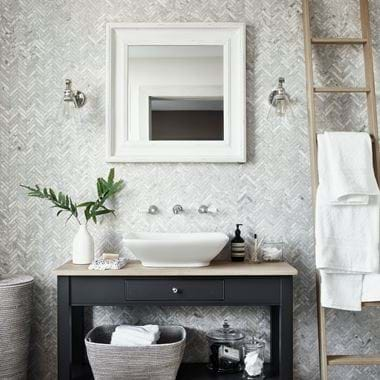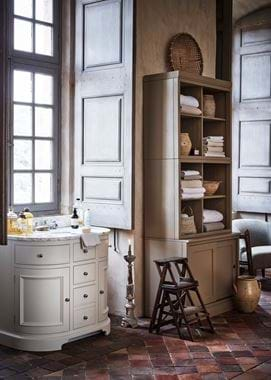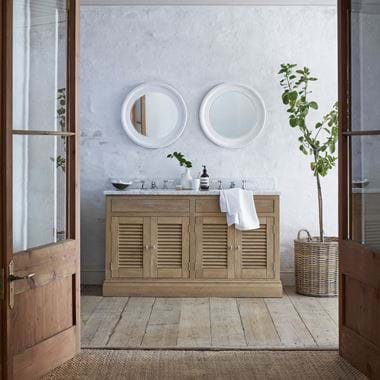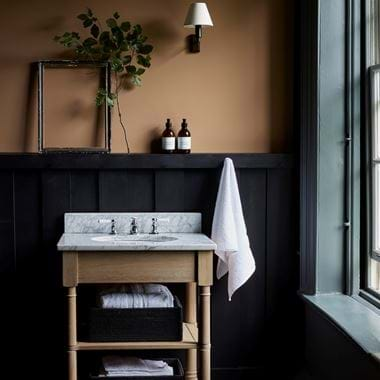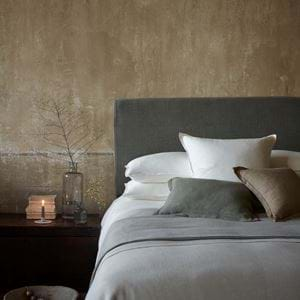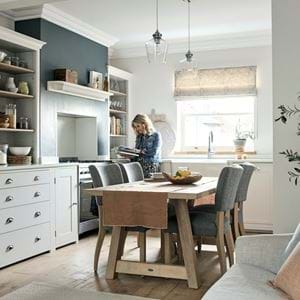Building a beautiful bathroom
Building a beautiful bathroom
For all its practical purpose, a bathroom is also a place to relax, to spend time in your own company and to generally recharge in order to go out and see the world again feeling (as well as literally being) bright and shiny once more. Even a family bathroom shared with little ones or teenagers needs to be somewhere everyone – yourself included – can unwind. So why is it that we so often fill them with cold, hard surfaces, paint them starkly white and light them with the harshest of beams? Here, we’re going to advocate a softer, gentler kind of bathroom decorating that’ll help you create a space as warm, inviting and considered as any living room or bedroom. Grab a cup of tea, we’ve got a lot to share…
Getting the foundation right
There’s often a temptation with bathrooms to tile across the floor, up to the ceiling and from wall to wall. Practical, yes, and certainly necessary in a wet room (in which case, we’d suggest going for a tile with some natural or handmade texture so it’s not so mausoleum-like), but also a bit chilly and rather echoey. There’s nothing about tiles that gives the impression of a warm and soothing embrace, which, after all, is how you should feel when stepping into your bathroom.
Paint and timber, on the other hand, are full of warmth, being literally warmer to the touch and also, thanks to their matt or semi-matt appearance, visually softer. (They’re also, happily, less expensive.) We’d therefore suggest that you limit tiles to the walls immediately surrounding your shower, and opt for a hardwearing and wipeable painted finish elsewhere, like timber panelling painted in eggshell. This also has the added advantage over plain paint of bringing texture to your walls and, if you stop the panelling part-way up, it can incorporate a small shelf on which to lean pieces of art or rest bud vases and pretty bottles. And it’s perfectly possible to use it around a bath or sink, just choose water-resistant panelling in this case and, if you’re panelling the front of a fitted bath too, then make sure the lines match up with those on the wall.
And now to floors. If you do use tiles or, if the budget will stretch, natural stone here, make sure you incorporate underfloor heating. It’ll absolutely make all the difference on winter mornings. But, you can absolutely use timber too. If you’re lucky enough to have proper wooden floorboards, then embrace them. They’ll add such a lot of character and warmth and, while they may move a little and you may get the odd creak here or there, if they’ve been properly seasoned (which, if they’re original to your home, they certainly will be) and you keep the space well-ventilated, this should be minimal. If you are worried about warping though, opt for engineered boards. These are made from actual wood, unlike laminate, but because they’re built up in layers of thin strips, they really won’t move.
Adding in furniture, including storage
There are a couple of reasons why, here at Neptune, all the bathroom sinks we create are part of washstands (or vanities, whichever term you prefer). The first is that the ‘dead’ area around a sink’s waste pipe seems too good an opportunity to squeeze in some storage to miss. And the second is that we believe a bathroom, just like any other room in your home, deserves properly built furniture too, and all our washstands are built with the same level of craftsmanship as any of our tables or kitchen cabinets.
So extend that principle to the rest of your room too. Starting with any extra storage. If you’ve got the space in your bathroom, then it’s a good place to have your linen cupboard which, as well as keeping bedding in close proximity to the bedrooms, can store towels, face cloths and toiletries. A freestanding housekeeper’s cupboard would be particularly lovely as it’ll add character as well as being practical. While our Chawton cabinet has the added advantages of being modular (you can make it as small or as big as you need/can) and having open shelves for displaying prettier pieces.
Now, bring in other pieces of furniture. There’s nothing more homely than a petite armchair in a bathroom, if you have room, because it introduces the softness of fabric. It’ll also make a nice spot for someone to perch and chat to you while you’re in the bath, or simply be a place to temporarily drape your clothes. The only thing we’d say is avoid velvet because it’ll mark too easily, and patterned fabrics will be more forgiving. Try to incorporate a little stool – like Northwich or Beswick – or a side table next to the bath too, where you can keep soap and a candle, not to mention rest your book and cup of tea. Being comfortable is all about having everything you need within arm’s reach.
Shining a light
Lighting a bathroom successfully, like any other room, is about layers. Quite simply, you’ll want to incorporate a few (not too many!) recessed, overhead lights for when all-over illumination in needed (like when you’re rummaging in a cupboard), wall lights on either side of your mirror to shine an even light on your face, and if you can, a softer way to light the room when you’re in the bath. This could be wall lighting near to the bath, or (or as well as that) it could be making sure everything is on a dimmer switch.
IP44 is something you may have heard of, and it’s definitely something to know about if you’re lighting a bathroom. It’s an industry standard rating that specifies the lights which are suitable for using near a water source, i.e. your bath and sink. There are actually several IP ratings but all you really need to know is that, if your lights are placed within 60cm of your bath or sink, then they need to be IP44 rated. Outside of that, you can use normal wall lights. If your light is also less than 2.25 metres immediately above your bath, it should be IP65 rated. Our Brunswick wall lights (which come in nickel or bronze) are the ones in our collection that are IP44 rated.
In any case, try to choose wall lights that come with fabric shades. These will diffuse the light more softly and, again, are a great opportunity to introduce softness and colour. Brunswick can be fitted with a shade; we suggest either the Oliver 8 inch, Henry 7.5 inch or the Brunswick shade, which is 5.5 inches in diameter. And last but not least, always, always use warm white bulbs.
Accessorising, dressing and prettifying
Like panelling on the walls and timber on the floors, ignore the naysayers that suggest you can’t use things like framed pictures, proper rugs (as opposed to just bath mats) and fabric blinds or curtains in a bathroom. Just ventilate the space well and keep them away from the immediate vicinity of the shower. These are the kinds of things that bring life to a bathroom, just like they do any other space in your home, so it’s important to include at least some.
Other opportunities for adding personality come where the practical meets the pretty. Think china dishes as soap trays, baskets to hold loo rolls or as wastepaper bins, antique bottles for decanting bath oils into, coloured glasses for toothbrushes, vintage-inspired jars in which to store cotton wool, decorative hooks on which to hang towels, and, indeed, towels with decorative borders.
And don’t forget a plant or a small posy of flowers: the ultimate ‘accessories’ for bringing life – and, in turn, welcoming warmth – to a room.
You’ll find all our bathroom and accessory collections online, as well as in store. And if you need an expert guiding hand when decorating your bathroom, our Home Design Service is here to help.

